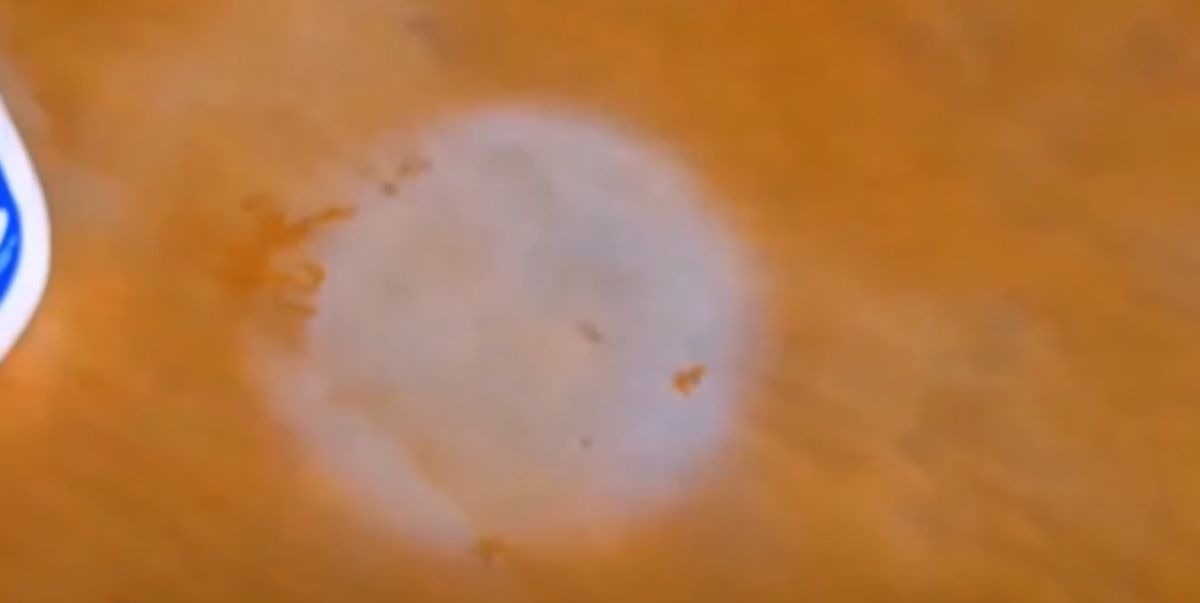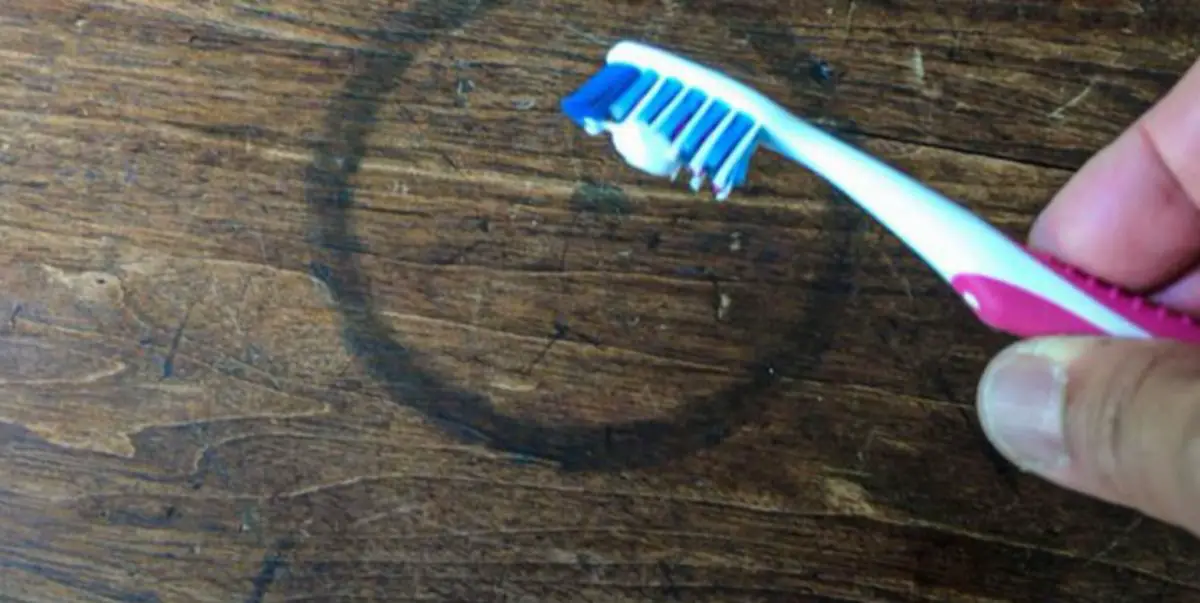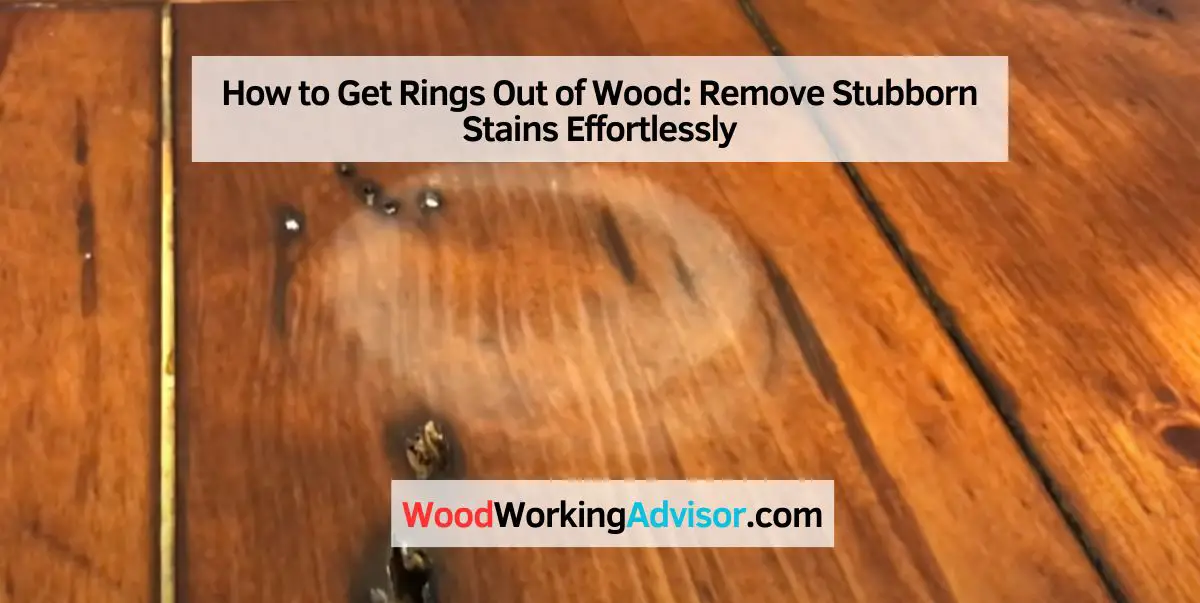To get rings out of wood, gently heat the wood using an iron and a clean cloth.
Understanding Stubborn Stains In Wood
Understanding stubborn stains in wood is crucial if you want to keep your wooden furniture looking its best. Over time, rings and stains can develop on the surface of wood, tarnishing its natural beauty. However, with the right knowledge and tools, you can effectively remove these blemishes and restore the wood’s original luster. In this section, we will explore the various types of stains that can affect wood and understand their impact.
Identifying Different Types Of Stains
Before you can tackle stubborn stains in wood, it’s important to identify their type. Here are some common types of stains:
| Stain Type | Description |
|---|---|
| Rings | Rings typically occur when a wet object is placed on the wood surface, causing moisture to penetrate and leave a circular mark. |
| Water Stains | Water stains are caused by prolonged exposure to moisture. They often appear as pale, discolored patches on the wood. |
| Ink Stains | Ink stains can occur when a pen or marker leaks onto the wood’s surface. They can be challenging to remove due to their deep pigmentation. |
| Oil and Grease Stains | Oil and grease stains are common in kitchen areas. They can leave unsightly dark spots on the wood surface. |
| Heat Marks | Heat marks are the result of placing hot objects directly on the wood, causing discoloration and sometimes even scorching. |
Impact Of Stains On Wood
The presence of stains can significantly impact the appearance and value of your wooden furniture. They not only detract from the natural beauty of wood but can also lead to permanent damage if left unaddressed. Here are some ways stains can affect wood:
- Discoloration: Stains can leave behind unsightly marks, altering the color and visual appeal of the wood.
- Erosion: Certain stains, such as water stains, can eat away at the wood’s protective finish, leaving it vulnerable to further damage.
- Structural Weakness: In severe cases, stains can weaken the wood’s structure, leading to cracks or warping.
- Reduced Value: When selling or appraising wooden furniture, the presence of stains can decrease its value and desirability in the market.
Now that you have a better understanding of the different types of stains and their impact on wood, you can proceed with confidence in removing these stubborn blemishes. In the next section, we will delve into practical techniques and methods to get rid of rings and stains from wood.

Common Methods For Removing Wood Stains
When it comes to removing stubborn wood stains like rings, it’s important to know the common methods that can help restore the natural beauty of your wooden furniture or floors. In this article, we will discuss three effective techniques for removing wood stains: sanding, chemical strippers, and solvents. Let’s delve into each method and explore its benefits and applications.
Sanding Techniques
Sanding is a widely used technique for removing wood stains from various surfaces. This method involves using sandpaper or a sanding block to gently sand the stained area until the stain is completely removed. Remember to always start with a finer grit sandpaper and gradually work your way up to coarser grits if necessary, to prevent damaging the wood.
Chemical Strippers And Solvents
Chemical strippers and solvents are powerful solutions that can effectively remove tough wood stains. These products work by breaking down the stain’s bond with the wood, making it easier to wipe away. Before using any chemical stripper or solvent, it’s important to read and follow the manufacturer’s instructions carefully to ensure safety and optimal results.
| Benefits of Using Chemical Strippers and Solvents |
|---|
|
It’s important to note that when using chemical strippers and solvents, proper ventilation and protective gear such as gloves and goggles should be used to ensure personal safety.
Whether you choose sanding or using chemical strippers and solvents, always remember to test the technique on a small, inconspicuous area before tackling the entire stained surface. This will help you assess the effectiveness of the method and avoid any potential damage to your wood. With persistence and the right method, you can effectively remove those unsightly wood stains and restore the natural beauty of your wooden pieces.
Effective Natural Remedies
When it comes to removing rings from wood, natural remedies can be effective and safe. Using ingredients commonly found in the kitchen, you can successfully eliminate unsightly rings without damaging the wood’s surface. Let’s explore two effective natural remedies that can help you get rings out of wood.
Using Baking Soda And Vinegar
Start by making a paste using equal parts of baking soda and white vinegar. Gently apply the paste to the affected area using a soft cloth, rubbing in a circular motion. Allow the paste to sit for a few minutes before gently wiping it off with a clean, damp cloth. Repeat the process as needed until the ring disappears.
Lemon And Salt Method
Create a natural cleaning solution by mixing fresh lemon juice and table salt to form a paste. Apply the paste to the affected area, gently buffing in a circular motion. Let the paste sit for a few minutes, then wipe it off with a clean, damp cloth. The natural acidity of the lemon juice combined with the abrasive texture of the salt can help lift the ring from the wood surface.
Specialized Techniques For Unyielding Stains
Discover specialized techniques to efficiently remove stubborn rings from wood surfaces. By following these proven methods, you can effectively eliminate unyielding stains and restore the natural beauty of your wooden furniture or floors. With these strategies, you can easily rejuvenate your wood surfaces and keep them looking their best.
When it comes to removing rings and stains from wood, sometimes the standard methods just won’t cut it. Certain stains can be particularly stubborn and require specialized techniques to effectively remove them. In this article, we will explore two such techniques: Heat Treatment and Oxalic Acid Application.
Heat Treatment
Heat treatment is a method that can be used to remove deep-set stains from wood. This technique involves using heat to draw out the moisture and oils that are trapped within the wood fibers, effectively reducing the appearance of the stain. To perform heat treatment on a wood surface, follow these steps:
- Place a clean, white cloth over the stain.
- Set your iron to a medium heat setting.
- Gently iron the cloth in a circular motion over the stain, applying light pressure.
- Continue ironing for a few minutes, periodically checking the stain’s progress.
- Once the stain appears to be lifted, remove the cloth and let the wood surface cool.
- If necessary, repeat the process until the stain is completely gone.
Heat treatment can be an effective way to remove deep-seated stains, but it is important to exercise caution when using this method. Always test a small, inconspicuous area of the wood first to ensure that it can withstand the heat without any damage.
Oxalic Acid Application
Oxalic acid is a powerful chemical compound that can be used to remove tough stains from wood, including water marks and rings. Here’s how you can use oxalic acid to tackle unyielding stains:
- Dissolve a small amount of oxalic acid powder in warm water, following the instructions on the packaging.
- Using a clean cloth or sponge, apply the oxalic acid solution directly to the stained area.
- Gently rub the solution into the stain in a circular motion, making sure to cover the entire affected area.
- Allow the solution to sit on the stain for the recommended amount of time, as indicated on the packaging.
- Thoroughly rinse the area with clean water to remove any residue.
- Repeat the process if necessary until the stain is no longer visible.
Remember to wear protective gloves and work in a well-ventilated area when using oxalic acid. It is also advisable to test the solution on a small, inconspicuous area of the wood before applying it to the stain to ensure compatibility.
Precautions And Aftercare
Learn how to safely remove rings from wood with these essential precautions and aftercare tips. Follow these guidelines to avoid damage and ensure a smooth process.
Protective Gear
Before attempting to get rings out of wood, it’s crucial to ensure your safety by using the necessary protective gear. Wearing gloves and safety goggles will protect your hands and eyes from any potential harm. Even though this task may seem simple, accidents can happen, and it’s better to be safe than sorry.
Ventilation
Another important consideration when working with wood is proper ventilation. Make sure you are in a well-ventilated area or have a fan or open windows to allow for fresh air circulation. This is especially important when using chemicals or solvents as part of the wood restoration process.
Restoring And Protecting Wood
Restoring wood after removing a ring or stain is essential to maintain its natural beauty and longevity. Follow these simple steps to restore and protect the wood surface:
- Prepare the surface: Begin by cleaning the wood with a mild soap and water mixture. Using a soft cloth, gently scrub the affected area, making sure to remove any dirt or debris.
- Sand the surface: After cleaning, lightly sand the wood in the direction of the grain using fine-grit sandpaper. This will help to smooth out any imperfections and prepare the surface for restoration.
- Apply wood stain or filler: If the ring or stain has caused significant damage to the wood, you may need to use a wood stain or filler to restore the appearance. Choose a color that matches the original wood tone and apply it according to the product instructions.
- Protect with a sealant: To prevent future damage, apply a wood sealant or finish over the restored area. This will help protect the wood from moisture, stains, and scratches, ensuring its longevity.
Remember to always follow the instructions provided by the manufacturer for any products you use during the restoration process.

Frequently Asked Questions On How To Get Rings Out Of Wood
Is There A Way To Get Water Rings Out Of Wood?
To remove water rings from the wood, mix equal parts vinegar and olive oil. Apply the mixture to the affected area. Let it sit for several hours or overnight, then wipe it off with a clean cloth. Repeat as needed until the water rings are gone.
Are Water Stains On Wood Permanent?
Water stains on wood are not always permanent. They can often be removed by using wood cleaners or by sanding and refinishing the affected area. Taking preventive measures, such as using coasters and protective finishes, can also help avoid water stains on wood furniture.
How Do You Get Dark Rings Out Of Wood?
To remove dark rings from the wood, mix equal parts of vinegar and olive oil and apply it to the affected area. Let it sit for a few hours, then wipe it off with a clean cloth. You can also use non-gel toothpaste or a mixture of baking soda and water.
How Do You Remove Hot Ring Marks From Wood?
To remove hot ring marks from the wood, gently rub the affected area with a combination of mayonnaise and baking soda. Leave it for a few hours, then wipe it off with a clean cloth. Apply wax or furniture polish to restore shine.
Conclusion
Removing rings from wood can be done using various techniques. Whether it’s using steam or sanding the surface, there are effective methods to restore your wooden furniture’s beauty. Remember to be patient and take your time to achieve the best results.
With the right tools and care, you can easily remove rings and stains from wood surfaces.


